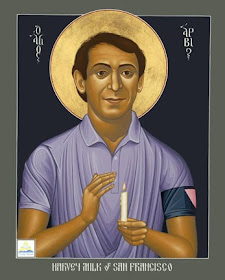 Harvey Milk of San Francisco
Harvey Milk of San FranciscoBy Brother Robert Lentz, OFM. Copyright 1987
Courtesy of www.trinitystores.com (800.699.4482)
 Pioneering gay rights activist Harvey Milk (1930-1978) was assassinated on Nov. 27, 1978 (32 years ago today). Milk is the first and most famous openly gay male elected official in California, and perhaps the world. He became the public face of the LGBT rights movement, and his reputation has continued to grow since his death. He has been called a martyr for GLBT rights.
Pioneering gay rights activist Harvey Milk (1930-1978) was assassinated on Nov. 27, 1978 (32 years ago today). Milk is the first and most famous openly gay male elected official in California, and perhaps the world. He became the public face of the LGBT rights movement, and his reputation has continued to grow since his death. He has been called a martyr for GLBT rights.“If a bullet should enter my brain, let that bullet destroy every closet door in the country,” Milk said. Two bullets did enter his brain, and his vision of GLBT people living openly is also coming true.
Milk has received many honors for his visionary courage and commitment to equality. He is the only openly gay person in the United States to have an official state holiday in his name. Harvey Milk Day is celebrated in California on Milk’s birthday, May 22. The bill establishing Harvey Milk Day was signed in to law in fall 2009, and the holiday was celebrated for the first time this year. State employees still have to work on Harvey Milk Day, but California public schools are encouraged to teach suitable commemorative lessons about the gay rights activist.
In 2009 Milk was posthumously awarded the Presidential Medal of Freedom and inducted into the California Hall of Fame. He was included in the Time “100 Heroes and Icons of the 20th Century” for being “a symbol of what gays can accomplish and the dangers they face in doing so.”
He is the subject of two Oscar-winning movies, “Milk
Milk was elected to the San Francisco Board of Supervisors in 1977 after three unsuccessful efforts to run for office. He served only 11 months before he was killed, but in that short time he was responsible for passing a tough gay-rights law.
Haunted by the sense that he would be killed for political reasons, Milk recorded tapes to be played in the event of his assassination. His message, recorded nine days before his death, included this powerful statement:
“I ask for the movement to continue, for the movement to grow, because last week I got a phone call from Altoona, Pennsylvania, and my election gave somebody else, one more person, hope. And after all, that's what this is all about. It's not about personal gain, not about ego, not about power — it's about giving those young people out there in the Altoona, Pennsylvanias, hope. You gotta give them hope.”
Shots fired by conservative fellow supervisor Dan White cut Milk’s life short. More than 30 years later, the hope and the movement for GLBT rights are more alive than ever.
The Harvey Milk icon painted by Robert Lentz (pictured above) was hailed as a “national gay treasure” by gay author/activist Toby Johnson. Milk holds a candle and wears an armband with a pink triangle, the Nazi symbol for gay men, expressing solidarity with all who were tortured or killed because of their sexuality.
It is one of 10 Lentz icons that sparked a major controversy in 2005. Critics accused Lentz of glorifying sin and creating propaganda for a progressive sociopolitical agenda, and he temporarily gave away the copyright for the controversial images to his distributor, Trinity Stores. All 10 are now displayed there as a collection titled “Images That Challenge.”
_________
This post is part of the GLBT Saints series at the Jesus in Love Blog. Saints and holy people of special interest to gay, lesbian, bisexual and transgender (GLBT) people and our allies are covered on appropriate dates throughout the year.
An interesting discussion is underway on my Facebook page about whether it’s appropriate to have a Christian-style icon of a man who was a Jew… meaning Harvey Milk (not Jesus).
ReplyDeleteThat IS interesting - as both were Jews!
ReplyDelete